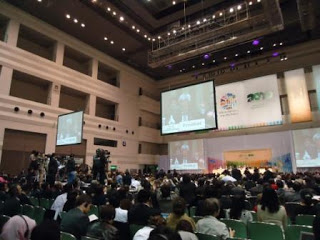
After 6 years of intensive and politically fraught negotiations, the 10th Conference of the Parties to the Convention on Biological Diversity (CBD COP10) finally adopted the Aichi Nagoya Protocol on Access and Benefit Sharing at 2:00 AM on the morning of October 30th, 2010. The last couple of hours before its adoption were extremely tense with the European Union insisting that the Protocol be adopted as a package deal with the resolution on the Strategic Plan and the Financial Mechanism. On the other side were Cuba, Bolivia, Ecuador, Venezuela, and Uruguay expressing grave reservations about the Protocol as another attempt by developed countries to legitimize biopiracy and commodify Nature. These countries also insisted that the Protocol not be adopted as a package deal but rather that the Protocol be adopted first and then the Strategic Plan and the Financial Mechanism.
It was a difficult moment for the Japanese presidency, which was confronted with a classic ‘Mexican standoff’. The EU refused to relent, saying that they will sign off on the Protocol only if the other Parties signed off on the ambitious targets of the Strategic Plan and the Financial Mechanism. Cuba, however, was insistent that they would block any package deal and that each resolution would have to be adopted individually; if this wasn’t agreed, Cuba said that they would block the Protocol itself. The G77 and China, which constituted the majority of developing countries, watched this absurd high-stakes game with growing horror. On the one hand was the EU’s last-minute effort at getting concessions out of developing countries by tying the Protocol to the Financial Mechanism and the Strategic Plan and on the other hand were kamikaze moves by Cuba, Bolivia, and Venezuela, who said they didn’t care if the Protocol was killed, they would not back down.
Finally, the COP presidency came up with a solution that each of the COP decisions would be confirmed individually – in essence, to make sure that there were no objections to the Protocol, the Financial Mechanism, and the Strategic plan, taking each of them one by one and resolving any disagreement that may arise. This satisfied Cuba, Bolivia, and Venezuela and indicated that only if there were a consensus on the three COP decisions would they be adopted. This would then give the EU a chance to assess whether or not it would want to adopt the Protocol depending on the outcomes of the discussions on the Strategic Plan and the Financial Mechanism.
Ultimately, and after much discussion, the Protocol, the Financial Mechanism, and the Strategic Plan were all adopted. Cuba, Venezuela, and Bolivia insisted that while they would not stand in the way of the adoption of the Protocol, and they would want their concerns reflected in the COP report.
The Aichi Nagoya Protocol is a monumental achievement by developing countries to ensure justice. It affirms equity and fairness by establishing the rights of countries and communities over their genetic resources and ensures fair and equitable sharing of benefits arising from the utilization of these genetic resources. The Protocol is also a milestone regarding the recognition of stewardship rights of Indigenous peoples and local communities (IPLCs). For the first time in international law, it recognizes the inseparable link for IPLCs between their genetic resources and associated traditional knowledge. It also affirms the rights of IPLCs not just over their traditional knowledge but also their genetic resources, which is an incredible advance from the CBD’s previous stance on this issue. Most importantly, for the first time in international treaty law, the Protocol recognizes customary laws and community protocols of IPLCs, paving way to a future of legal pluralism.
